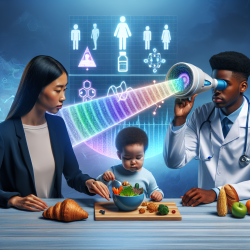Introduction
In the realm of speech-language pathology, especially when working with children, nutrition plays a pivotal role in cognitive and language development. The recent study titled "Pressure-Mediated Reflection Spectroscopy Criterion Validity as a Biomarker of Fruit and Vegetable Intake" offers a promising avenue for practitioners to enhance their nutritional assessments. This blog delves into how these findings can be leveraged to improve child outcomes in educational settings.
The Study in Focus
The research conducted by Jilcott Pitts et al. (2022) explored the validity of using pressure-mediated reflection spectroscopy (RS) as a non-invasive method to measure skin carotenoids, which are indicative of fruit and vegetable (FV) intake. This method was compared against traditional plasma carotenoid concentration measures and self-reported dietary intake across diverse racial and ethnic groups.
Key Findings
- RS-assessed skin carotenoids showed a strong correlation (r = 0.71) with plasma carotenoids, indicating its potential as a reliable proxy for FV intake.
- The method demonstrated consistency across racial and ethnic groups, making it suitable for diverse populations.
- Skin carotenoid measurements were less influenced by self-reporting biases, which are common in dietary assessments.
Implications for Practitioners
For speech-language pathologists and educators, understanding the nutritional status of children can inform interventions that support language and cognitive development. Here’s how practitioners can apply these findings:
- Adopt Non-Invasive Techniques: Implement RS devices like the Veggie Meter in schools to regularly monitor children's FV intake without the need for invasive blood draws.
- Tailor Interventions: Use the data from RS assessments to tailor nutritional interventions that support language development, especially in children who may be at risk of undernutrition.
- Promote Inclusivity: Given the method's validity across diverse groups, practitioners can confidently apply it in multicultural settings, ensuring all children receive equitable nutritional assessments.
Encouraging Further Research
While this study provides a solid foundation, further research is encouraged to explore the sensitivity of RS in detecting changes in FV intake over time, especially in response to dietary interventions. Additionally, examining the interaction between skin carotenoids and other factors such as genetic variations could offer deeper insights into personalized nutrition strategies.
Conclusion
The integration of reflection spectroscopy in nutritional assessments represents a significant advancement in creating data-driven, equitable, and effective interventions for children's development. By embracing these innovative methods, practitioners can enhance their impact on child health and educational outcomes.
To read the original research paper, please follow this link: Pressure-Mediated Reflection Spectroscopy Criterion Validity as a Biomarker of Fruit and Vegetable Intake: A 2-Site Cross-Sectional Study of 4 Racial or Ethnic Groups.










